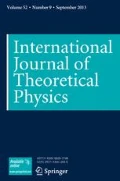Abstract
We have made an attempt to describe the octonion formulation of Abelian and non-Abelian gauge theory of dyons in terms of 2×2 Zorn vector matrix realization. As such, we have discussed the U(1) e ×U(1) m Abelian gauge theory and U(1)×SU(2) electroweak gauge theory and also the SU(2) e ×SU(2) m non-Abelian gauge theory in term of 2×2 Zorn vector matrix realization of split octonions. It is shown that SU(2) e characterizes the usual theory of the Yang Mill’s field (isospin or weak interactions) due to presence of electric charge while the gauge group SU(2) m may be related to the existence of ’t Hooft-Polyakov monopole in non-Abelian Gauge theory. Accordingly, we have obtained the manifestly covariant field equations and equations of motion.
Similar content being viewed by others
References
Dirac, P.A.M.: Quantized singularities in the electromagnetic field. Proc. R. Soc. Lond. A 133, 60 (1931)
Saha, M.N.: Note on Dirac’s theory of magnetic poles. Phys. Rev. 75, 1968 (1949)
Malkus, W.: The interaction of the Dirac magnetic monopole with matter. Phys. Rev. 83, 899 (1951)
Goto, E.: Expected behaviour of the Dirac monopole in the cosmic space. Prog. Theor. Phys. 30, 700 (1963)
Rosenbaum, D.: Direct action and magnetic monopoles. Phys. Rev. 147, 891 (1966)
Zwanziger, D.: A regular theory of magnetic monopoles. Phys. Rev. B 137, 647 (1965)
Goldhaber, A.S.: On the monopole-dyon system in non-Abelian Gauge theories. Phys. Rev. B 140, 1407 (1965)
Schwinger, J.: A magnetic model of matter. Phys. Rev. 144, 1087 (1966); [151, 1055 (1966)]
Goldhaber, A.S.: Spin and statistics connection for charge monopole composites. Phys. Rev. Lett. 36, 1122 (1976)
Zwanzinger, D.: Quantum field theory of particles with both electric and magnetic charges. Phys. Rev. 176, 1489 (1968)
Soper, A.: Multi-monopoles close together. Nucl. Phys. B 199, 290 (1982)
Wu, T.T., Yang, C.N.: Dirac monopole without strings: monopole harmonics. Nucl. Phys. B 107, 365 (1976)
Price, P.B.: Evidence for detection of a moving magnetic monopole. Phys. Rev. Lett. 35, 487 (1975)
Cabibbo, N., Ferrari, E.: Quantum electrodynamics with Dirac monopoles. Nuovo Cimento 23, 1147 (1962)
’t Hooft, G.: Magnetic monopoles in unified gauge theories. Nucl. Phys. B 79, 276 (1974)
Polyakov, A.M.: Particle spectrum in quantum field theory. JETP Lett. 20, 194 (1974)
Julia, B., Zee, A.: Poles with both magnetic and electric charges in non-Abelian gauge theory. Phys. Rev. D 11, 2227 (1975)
Prasad, M.K.: Yang-Mills-Higgs monopole solutions of arbitrary topological charge. Commun. Math. Phys. 80, 137 (1981)
Prasad, M.K., Sommerfield, C.M.: Exact classical solution for the ’t Hooft monopole and the Julia-Zee dyon. Phys. Rev. Lett. 35, 760 (1975)
Bogomolny, E.B.: Stability of classical solutions. Sov. J. Nucl. Phys. 24, 449 (1976)
Dickson, L.E.: On quaternions and their generalization and the history of the eight square theorem. Ann. Math. 20, 155 (1919)
Pais, A.: Remark on the algebra of interactions. Phys. Rev. Lett. 7, 291 (1961)
Koplinger, J.: Dirac equation on hyperbolic octonions. Appl. Math. Comput. 182, 443 (2006)
Gogberashvili, M.: Octonionic version of Dirac equations. Int. J. Mod. Phys. A 21, 3513 (2006)
Gogberashvili, M.: Octonionic electrodynamics. J. Phys. A, Math. Gen. 39, 7099 (2006)
Nurowski, P.: Split octonions and Maxwell equations. Acta Phys. Pol. A 116, 992 (2009)
Dzhunushaliev, V.: Colorless operators in a non-associative quantum theory. Phys. Lett. A 355, 298 (2006)
Dzhunushaliev, V.: Non-associativity, supersymmetry and hidden variables. J. Math. Phys. 49, 042108 (2008)
Nash, P.L.: Second gravity. J. Math. Phys. 51, 042501 (2010)
Demir, S.: Hyperbolic octonion formulation of gravitational field equations. Int. J. Theor. Phys. 52, 105 (2013)
Bisht, P.S., Pandey, B., Negi, O.P.S.: Interpretations of octonion wave equations. Fizika B 17, 405 (2008)
Chanyal, B.C., Bisht, P.S., Negi, O.P.S.: Generalized octonion electrodynamics. Int. J. Theor. Phys. 49, 1333 (2010)
Chanyal, B.C., Bisht, P.S., Negi, O.P.S.: Generalized split-octonion electrodynamics. Int. J. Theor. Phys. 50, 1919 (2011)
Dangwal, S., Bisht, P.S., Negi, O.P.S.: Octonionic gauge formulation for Dyonic fields (2006). arXiv:hep-th/0608061
Negi, O.P.S., Dehnen, H.: Gauge formulation for two potential theory of dyons. Int. J. Theor. Phys. 50, 2446 (2011)
Günaydin, M., Gürsey, F.: Quark structure and octonions. J. Math. Phys. 14, 1651 (1973)
Günaydin, M.: Octonionic Hilbert spaces, the Poincaré group and SU(3). J. Math. Phys. 17, 1875 (1976)
Catto, S.: Exceptional projective geometries and internal symmetries (2003). hep-th/0302079v1
Chanyal, B.C., Bisht, P.S., Li, T., Negi, O.P.S.: Octonion quantum chromodynamics. Int. J. Theor. Phys. 51, 3410 (2012)
Figueroa, J.M., Farrill, O.: Electromagnetic duality for children. www.maths.ed.ac.uk. Teaching-lectures (1998)
Olive, D.I.: Exact electromagnetic duality (1995). hep-th/9508089
Author information
Authors and Affiliations
Corresponding author
Rights and permissions
About this article
Cite this article
Chanyal, B.C., Bisht, P.S. & Negi, O.P.S. Octonionic Non-Abelian Gauge Theory. Int J Theor Phys 52, 3522–3533 (2013). https://doi.org/10.1007/s10773-013-1655-7
Received:
Accepted:
Published:
Issue Date:
DOI: https://doi.org/10.1007/s10773-013-1655-7


